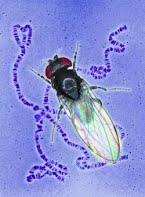The genetic basis of adaptation to captivity: the Drosophila subobscura model
Summary:Understanding the evolutionary and genetic mechanisms underlying adaptation is of importance not only for evolutionary biology in general, but in particular for the purpose of conservation. In a time of intense environmental change arising from human activities, the adaptation of wild species to rapid environmental change has become a pressing ecological issue. Furthermore, given the need to rescue some endangered species using ex situ populations, the evolutionary consequences of long term captivity are a particular concern for conservation genetics.
Our team has been using Drosophila subobscura as a model organism to study the evolutionary dynamics of adaptation to the laboratory, an approach that helps to reveal both the prospects for adaptive response to rapid environmental change in the wild as well as the evolutionary fate of captive populations. We have analysed in detail the evolutionary trajectories of life history traits, both in short and long term studies, comparing the evolution of multiple populations as a test for convergence and repeatability of results. We have been also characterizing changes in microsatellite markers in order to estimate the effects of genetic drift and to search for selective sweeps.
This project as a whole will constitute one of the most direct attempts to answer one of the most fundamental questions in evolutionary biology: what is the genetic basis of adaptation?
Working towards this goal we are:
- Analyzing changes in chromosomal polymorphisms and of molecular markers (microsatellites) in populations of Drosophila subobscura during adaptation to the laboratory. This species is particularly appropriate to test for the presence of co-adapted gene complexes sustained by inversions, because it is highly polymorphic for chromosomal inversions. It has long been known that there is a clear cline in the frequency of D. subobscura inversions with latitude. The inversion frequencies also change as a function of environmental temperature.
- Characterizing temporal changes in gene expression over the entire genome during local adaptation will allow us to search for candidate genes involved in the process. Moreover, the genetic basis of adaptation will be further analysed by crossing the information of the evolution of neutral markers, inversions and candidate genes localized within specific inversions. In a future project it may be interesting to sequence the most interesting candidate genes will then allow us to determine their role in the adaptive process in great detail.

